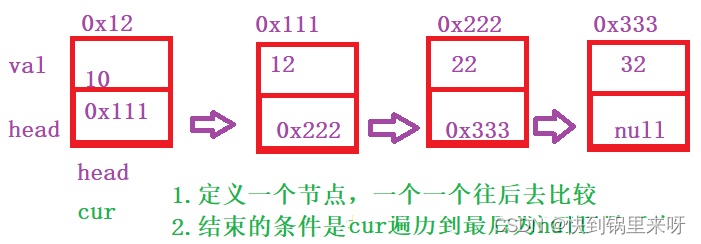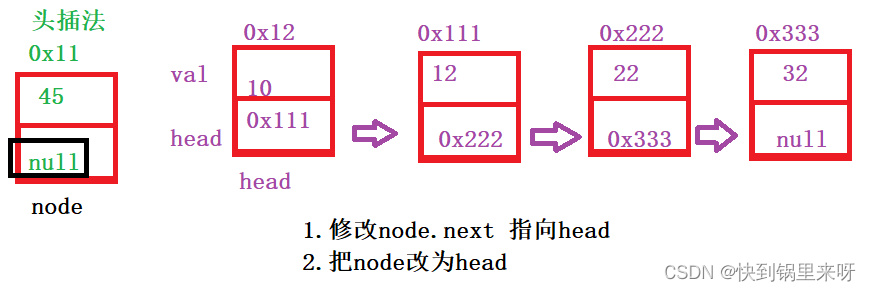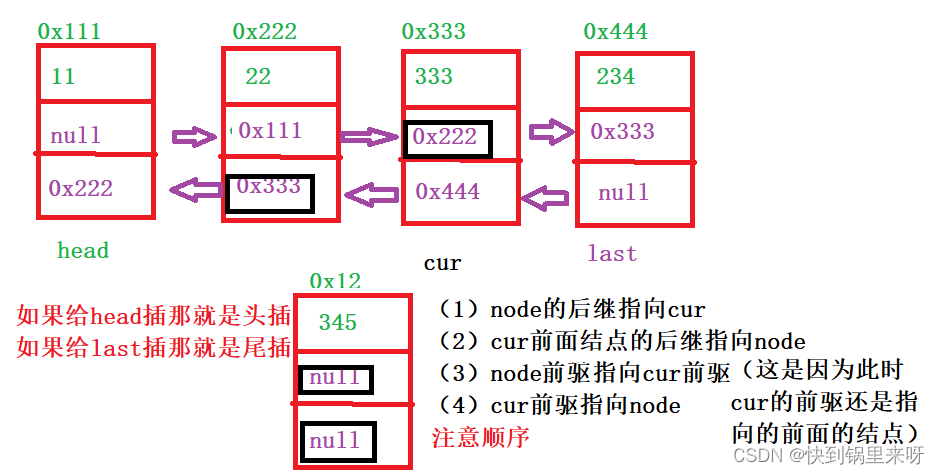目录
1.链表
1.1 链表概念和结构
链表是一种在物理存储结构上非连续的存储结构,
数据元素的逻辑顺序是通过链表中引用链接的顺序实现的

注意:(1)链式存储结构在逻辑上是连续的,在物理上不一定连续
(2)结点从堆中申请
说明,链表结构有8种

常用有两种
(1)单向 不带头 非循环:这个的特点是结构简单,所以实际中用作其他数据结构的子结构
(2)双向 无头 :在java集合框架中LinkedList底层就是无头双向循环链表实现的
1.2 链表实现
下面来写一个无头单向非循环链表的实现
先根据单链表结点写一个节点类
static class Node{
public int val;
public Node next;
public Node(int val) {
this.val = val;
}
}
public Node head;(1)打印单链表display()
public void display() {
while(this.head != null) {
System.out.print(this.head.val+" ");
this.head = this.head.next;
}
System.out.println();
}(2)查找是否包含关键字key是否在单链表当中contains()

public boolean contains(int key) {
Node cur =this.head;
while(cur != null) {
if (cur.val == key) {
return true;
}
cur = cur.next;
}
return false;
}(3)求链表长度size()
public int size() {
Node cur =this.head;
int count = 0;
while(cur != null) {
count++;
cur = cur.next;
}
return count;
}(4)头插法addFirst()

public void addFirst(int data) {
Node node = new Node(data);
node.next = head;
head = node;
}(5)尾插法addLast()

public void addLast(int data) {
Node node = new Node(data);
if (head == null) {
head = node;
}else {
Node cur = head;
while (cur.next != null) {
cur = cur.next;
}
cur.next = node;
}
}(6)任意位置插入,第一个数据节点为0号下标addIndex()

先写一个checkIndex()来判断index合不合法
private void checkIndex(int index) {
if (index < 0 || index > size()) {
throw new IndexNotLegalException("index位置不合法");
}
}如果不合法写一个异常
public class IndexNotLegalException extends RuntimeException{
public IndexNotLegalException() {
}
public IndexNotLegalException(String msg) {
super(msg);
}
}
然后让cur走到index前一个节点findIndexSubOfOne()
private Node findIndexSubOfOne(int index) {
Node cur = head;
while(index-1 != 0) {
cur = cur.next;
index--;
}
return cur;
}下面写index()
public void addIndex(int index, int data) {
checkIndex(index);
if (index == 0) {//头插法
addFirst(data);
return;
}
if (index == size()) {//尾插法
addLast(data);
return;
}
Node node = new Node(data);
Node cur = findIndexSubOfOne(index);
node.next = cur.next;
cur.next = node;
}(7)删除第一次出现关键字key的结点remove()

先找到所要删除结点的前驱searchPrevOfKey()
private Node searchPrevOfKey(int key) {
Node cur = this.head;
while(cur.next != null) {
if (cur.next.val == key) {
return cur;
}
cur = cur.next;
}
return null;
}下面写remove()
public void remove(int key) {
//如果删除头结点
if (head.val == key) {
head = head.next;
return;
}
Node cur = searchPrevOfKey(key);
if (cur == null) return;
Node del = cur.next;
cur.next = del.next;
}(8)删除所有值为key的结点removeAllKey()

public void removeAllKey(int key) {
if (head == null) return;
Node prev = head;
Node cur = head.next;
while(cur != null) {
if(cur.val == key) {
prev.next = cur.next;
cur = cur.next;
}else {
prev = cur;
cur = cur.next;
}
}
if (head.val == key) {
head= head.next;
}
}(9)清空链表clear()
public void clear() {
this.head = null;
}1.3 力扣-牛客上的一些链表面试题
这个是我写的一篇链表的题,感兴趣的可以看一下
2.LinkedList
2.1 LinkedList的使用
2.1.1 LinkedList结构
LinkedList底层是双向链表的结构,不是单链表
双向链表的节点组成

双向链表实现图示

特点:
(1)last记录保存最后一个节点的地址,如果要进行尾插法时,直接last.next就可以了
(2)双向链表的遍历是双向的
2.1.2 LinkedList实现的List接口

注意:
(1)LinkedList实现了List接口
(2)LinkedList的底层使用了双向链表
(3)LinkedList没有实现RandomAccess接口,所以LinkedList不支持随机访问
(4)LinkedList的任意位置插入和删除元素时效率比较高,时间复杂度为O(1)
2.1.3 LinkedList的使用
LinkedList构造 (1)无参构造 (2)利用其他集合容器中元素构造List
public static void main(String[] args) {
List<Integer> list = new LinkedList<>();
List<String> list1 = new ArrayList<>();
list1.add("xawl");
list1.add("xxgcxy");
list1.add("rjgc");
List<String> list2 = new LinkedList<>(list1);
}2.1.4 LinkedList 的遍历
(1)下标+for循环 (2)for-each(3)使用迭代器正向遍历(4)使用反向迭代器反向遍历
public static void main(String[] args) {
LinkedList<Integer> list = new LinkedList<>();
list.add(12);
list.add(25);
list.add(45);
list.add(67);
System.out.println("=====1.for+下标=======");
for (int i = 0; i < list.size(); i++) {
System.out.print(list.get(i) + " ");
}
System.out.println();
System.out.println("======2.for-each======");
for (int x : list) {
System.out.print(x + " ");
}
System.out.println();
System.out.println("=======3.迭代器-正向=====");
ListIterator<Integer> it = list.listIterator();
while(it.hasNext()) {
System.out.print(it.next() + " ");
}
System.out.println();
System.out.println("=====4.反向迭代器-反向=====");
ListIterator<Integer> it2 = list.listIterator(list.size());
while (it2.hasPrevious()) {
System.out.print(it2.previous() + " ");
}
}2.2 LinkedList模拟实现
先根据双向链表节点定义一个节点类
static class ListNode {
public int val;
public ListNode prev;
public ListNode next;
public ListNode(int val) {
this.val = val;
}
public ListNode head;(1)链表打印disPlay()
public void display() {
ListNode cur = head;
while(cur != null) {
System.out.print(cur.val + " ");
cur = cur.next;
}
System.out.println();
}(2)查找包含关键字key是否在链表当中contains()
public boolean contains(int key) {
ListNode cur = head;
while(cur != null) {
if (cur.val == key){
return true;
}
cur = cur.next;
}
return true;
}(3)求链表长度size()
public int size() {
int count = 0;
ListNode cur = head;
while(cur != null) {
count++;
cur = cur.next;
}
return count;
}(4)头插法addFirst()

public void addFirst(int data) {
ListNode node = new ListNode(data);
if (head == null) {
head = node;
last = node;
} else {
node.next = head;
head.prev = node;
head = node;
}
}
(5)尾插法addLast()

public void addLast(int data) {
ListNode node = new ListNode(data);
if (head == null) {
head = node;
last = node;
} else {
node.prev = last;
last.next = node;
last = last.next;
}
}
(6)任意位置插入,第一个数据节点为0号下标addIndex()
先获得index下标节点findInde()
private ListNode findIndex(int index) {
ListNode cur = head;
while(index != 0) {
cur = cur.next;
index--;
}
return cur;
}
public void addIndex(int index, int data) {
//1.检查index合法性
if (index < 0 || index > size()) {
throw new IndexNotlegalException("双向链表index不合法");
}
if (index == 0) {
addFirst(data);
return;
}
if (index ==size()) {
addLast(data);
return;
}
ListNode node = new ListNode(data);
//2.获取当前的index位置的结点地址
ListNode cur = findIndex(index);
node.next = cur;
cur.prev.next = node;
node.prev = cur.prev;
cur.prev = node;
}(7)删除第一次出现关键字为key的结点remove()
public void remove(int key) {
ListNode cur = head;
while (cur != null) {
//找到了删除
if (cur.val == key) {
if (cur == head) {
//1.删除头部
head = head.next;
if (head != null) {
//防止只有一个节点
head.prev = null;
}
} else {
cur.prev.next = cur.next;
if (cur.next != null) {
//2.删除中间结点
cur.next.prev = cur.prev;
} else {
//3,删除尾部
last = cur.prev;
}
}
return;
}
cur = cur.next;
}
}
(8)删除所有值为key的结点removeAllkey()
前(7)中删除一个值为key的结点,然后就return返回了
这里删除所有的key,那就不要return了直接全部找出来删除
public void removeAllKey(int key) {
ListNode cur = head;
while (cur != null) {
//找到了删除
if (cur.val == key) {
if (cur == head) {
//1.删除头部
head = head.next;
if (head != null) {
//防止只有一个节点
head.prev = null;
}
} else {
cur.prev.next = cur.next;
if (cur.next != null) {
//2.删除中间结点
cur.next.prev = cur.prev;
} else {
//3,删除尾部
last = cur.prev;
}
}
}
cur = cur.next;
}
}(9)清除所有结点clear()
public void clear() {
head = null;
last = null;
}3. ArrayList和LinkedList的区别
最直观的我们从二者的 增删查改 的时间复杂度进行比较

下来简单说一下
相同点:
(1)ArrayList和LinkedList都实现了这三个接口 java.util.List(支持泛型,都能用来存放各种类数据类型的对象)、Cloneable(能支持克隆)、java.io.Serializable(能够支持序列化)
(2)ArrayList和LinkedList都不是线程安全的,如果要在多线程情况下调用它们,可以使用Collertions类中的静态方法SynchronizedList(),或者用Vector
不同点
| ArrayList | LinkedLIst | |
|---|---|---|
| 实现方式 | 动态数组 | 双向链表 |
| 存储空间 | 一定连续 | 逻辑上连续,物理上不一定 |
| 随机访问 | 支持高效的随机访问 | 不支持 |
| 应用场景 | 高效存储+频繁访问 | 任意位置频繁插入删除 |
| 内存占用 | 存储数据+结点指向后 消耗小 | 存储数据+结点指向前+指向后 消耗大 |
| 插入 | 空间不够时需要扩容 | 没有容量的概念,只需拉链条 |
| 非线程安全 | 基于动态数组实现的非线程安全的集合 | 基于链表实现的非线程安全的集合 |